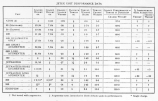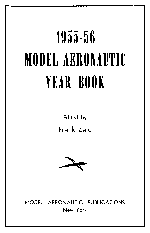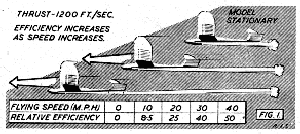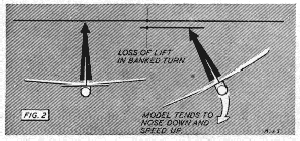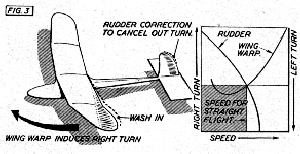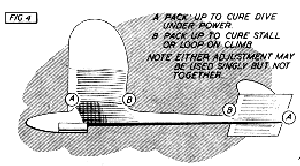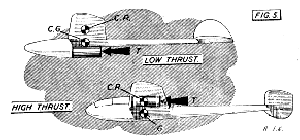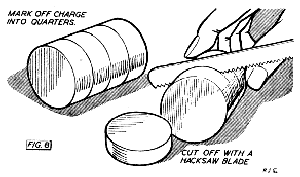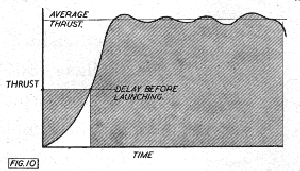These
articles are currently held here in the
archive:
Engine Analysis No. 15 (New Series) Part 1: The Jetex 350, 200 & Scorpion (Aeromodeller, Nov 1953)
Ron Warring To include tests on Jetex motors in a series of engine tests may seem a little strange but the rocket motor is just as truly an "engine" as an internal combustion engine and, furthermore, the Jetex is the only practical form of small scale jet unit at present suited to all types of free flight models. Its only rivals in this respect have been the compressed C02 jet "motor" (a capsule of compressed C02 suitably pierced to allow the compressed gas to escape at high velocity), and the more recent ducted fan. The former had many limitations and found only temporary favor The latter is, of course, merely another way of producing "propeller thrust" from a conventional motor and not in the same category as a pure jet engine. The Jetex motor, of course, delivers thrust direct, unlike the reciprocating engine which turns a shaft on which is mounted a suitable thrust-producer, e.g. a propeller or fan. In computing the respective performances the direct thrust of the jet engine is measured, whereas in the case of the internal combustion engine the power developed at the shaft is determined, and this varies with the load applied to the shaft (i.e. the size of the propeller). The resulting thrust, in the latter case, is a function of the efficiency of the propeller as well as the power of the engine. Due to inevitable propeller losses, in other words, the effective power of the engine (as expressed in terms of the useful thrust provided) is lower than the measured or brake horse power determined on test. These basic differences make direct comparison between jet engines and piston engines difficult. Nominally the thrust output of a jet engine remains the same, but the amount of useful work it does can only be determined with reference to the speed at which it flies the aircraft to which it is fitted. By combining the thrust of the jet engine (which can be measured by direct means) with the resulting speed of the engine-aeroplane combination, the equivalent horse power of the jet engine can be calculated. If this is compared with the brake horse power figures for piston engines, the comparison is flattering to the piston engine, since the B.H.P. figures takes no account of propeller losses when the piston engine is set to do the same job, i.e. produce thrust via a propeller. For a rough comparison of equivalent horse powers the effective horse power of the piston engine can be taken as three-quarters of the known brake horse power--a figure acceptable in full scale practice but still, probably, flattering to the piston engine in model sizes. With these facts in mind the significance of the horse power curves for the three Jetex engines tested can be appreciated. Once the thrust output of the Jetex has been determined (as the average of a number of test runs), the equivalent horse power can be calculated for different speeds. If the Jetex "Scorpion" flies a model at 30 m.p.h. for example, it is producing the equivalent of 0.025 horse power for all the time this speed is maintained. If it flies the model at 60 m.p.h. the equivalent horse power is 0.05 or somewhat higher than that likely to be achieved by a 0.05 c.c. diesel piston engine. Actually, from the designer's point of view, horse power figures for jet engines are not particularly valuable. The basic thrust figures are the ones which count most. In the case of a Jetex unit, its rated thrust determines the range of sizes of suitable models, optimum model size for duration work and also, together with the power weight ration of the Jetex determines the limits for airframe weight (i.e. total loading). It was the original intention to make up a suitable thrust testing rig to obtain figures for the whole range of Jetex motors. On a visit to the Wilmot Mansour factory to discuss the test programme it was found, however, that they already had a most efficient and accurate thrust testing machine which they agreed to loan to the Aeromodeller for the series of tests. The machine was checked, re-calibrated over the whole range of the scale with static hanging weights as a double check on accuracy and performed admirably throughout the tests. Jetex users will no doubt be interested to know that Wilmot Mansour do make extensive use of this machine in checking prototype and production Jetex units for performance--a very real interest being shown in continued development of the Jetex range, despite the fact that they have a virtual monopoly in this field. Bert Judge and Pete Cock are just two of the particularly well known aeromodellers on their staff. The principle of operation of the thrust testing machine is very simple. The Jetex unit is clamped to a suitable carriage suspended from knife edges. This carriage has a free horizontal travel substantially parallel with the base over the range of movement required, The end of the carriage bears against the vertical leg of an inverted "I" shaped crank, pivoted in the Contra of the bar. Pressure against this leg, as provided by the thrust of the Jetex moving the carriage forwards, produces a rotary movement of the "T" shaped member which is translated into a vertical "plunger" movement bearing down on top of a flexible chamber (a squat, cylindrical chamber with a rubber diaphragm top). This chamber is filled with a suitable fluid and the pressure transmitted to the flexible top forces excess fluid out of the chamber up into a vertical length of glass tube. The value of the pressure applied is a function of the height to which the liquid is raised in the glass tube. The scale alongside the tube is calibrated by means of hanging weights applied, via suitable pulleys, to the carriage. A suitable zero adjustment is fitted to vary the initial pressure in the fluid capsule so that the column of fluid can be adjusted to the zero mark, as required, prior to any tests. As for the test procedure itself, this was basically straightforward--charging, mounting and lighting the Jetex and then recording thrust figures at regular intervals over the duration of the run. Readings were actually taken at two second intervals, an assistant reading off the seconds from a stopwatch whilst the operator studied the scale and noted the reading of the liquid level at each stated interval. The resulting thrust figures plotted on the graphs are the average of some fifteen to twenty separate runs in each case. The curves are also “smoothed,” in the sense that the “wide scatter” experienced, particularly over the first few seconds of the run, has largely been ignored. A pen recorder coupled to the thrust indicating arm, for instance, would have produced a curve of the same basic outline but with a wiggly, rather than a smooth line. The average of a large number of readings was taken since separate runs with identical Jetex units tend to be inconsistent. There are, a variety of reasons for this, connected with both the charges and the condition of the Jetex itself. Despite all efforts on the part of Imperial Chemical Industries (the manufacturers of the solid fuel charges) the charges themselves are far from consistent. Some show a twenty-five per cent. loss of power (thrust) as compared with, perhaps, the next one out of the same box. This is something Jetex users will have to accept. However, the condition of the Jetex unit is something over which the operator has some control. What are, apparently, small factors can cause an appreciable loss of power. If the wire core of the fuse is not ejected completely from the nozzle when the charge builds up to full thrust, for example, the obstruction in the jet stream can result in an appreciable loss of thrust. Leakage between the end cap and body is also another common source of thrust losses--due to improper assembly or a burnt washer not seating properly. For maximum performance from any Jetex motor careful and regular maintenance is essential--frequent replacement of the gauze holding the fuse against the charge (once every third firing would appear good practice), keeping the jet hole properly clean, careful cleaning and assembly, and so on. In other words, the instructions on cleaning and maintenance given with each Jetex unit are there to be followed--they are not put in to persuade you to buy more spares and accessories than you need. Cost is, of course, one of the main criticisms levelled against the Jetex unit. On the face of it operating costs are high, but on an overall basis they are not. A week-end's flying with a diesel. powered model is likely to work out more expensive on fuel alone, flight for flight. The one great virtue or the Jetex unit, by comparison, is then its virtual indestructibility. The two other "complaints" about Jetex flying are that re-loading is a dirty business and handling a hot motor to fit a new charge can be a painful process! To the former there is no answer, except that most model engines are "dirty". Certainly the use of a Jetex unit keeps the model cleaner than with a diesel. And, of course, for the most pleasurable operation of Jetex models two or perhaps three separate motors, used alternately, will allow each to cool down adequately for comfortable handling between flights. That, however, is making for expensive flying although the Jetex being so readily inter-changeable does encourage the enthusiast to stick to one size of motor and accumulate a stock of such units. As to the individual units, the Jetex 350 is a “strong man's motor.” It is an excellent prospect for duration flying, both on account of its high average thrust and the fact that the effective power run can be as high as 36 seconds (with three charges). Frequent assembly and dissembly of the five strong spring clips holding the cap in place is, however, a little hard on the hands! On test, the "350" unit produced considerably higher thrust figures than those claimed by the manufacturers. Average thrust approached 4 ounces maintained over a period of about eight or nine seconds. The initial build-up of thrust is fairly slow, but there was no great delay between the firing and thrust build-up of the second and third charges. Each charge did, however, produce a marked surge at the beginning of the run and there was a slight tendency for the average thrust to increase with succeeding charges. Operating with one charge only loaded in the bottom of the unit produced an almost identical thrust run to that achieved with the first charge when all three were loaded. The marked variation between the highest and lowest figures achieved over a single run are noted on the graph and can be attributed to variations in the fuel charges themselves. By comparison the "Jetex 200" produced an appreciably higher average thrust from the second charge on a two-charge run and also the delay between the first charge fizzling out and the second one cutting in properly was most marked. This change-over delay can be shortened by sandwiching a coil of fuse between the two charges or slightly hollowing out the lower charge and covering with a layer of powdered charge before inserting the final fuel pellet. In the case of the "200" again the thrust was appreciably higher than that originally quoted for the unit-average thrust exceeding 3 ounces for the second charge. For duration contest work, therefore, where flight time is computed as a ratio of total duration to length of power run, loading a "200" with two charges, firing in the normal way but not releasing the model until the second charge has built up its proper thrust is expensive, but good practice. As a matter of interest loading with a single charge and heating the whole unit prior to firing produced a higher thrust figure than from a single charge fired in the "cold" state, but this practice is definitely not recommended. The Scorpion--the most powerful Jetex unit in the range was the last to be tried in this first series of tests and, apart from its higher thrust output, the most outstanding feature was the delightfully easy way in which it could be assembled and dissembled. No spring- loaded wire clips to struggle with-just two spring rollers which snap in place with delightful ease and a novel tubular mount for the whole unit which makes it just as easy to detach from the model, even when still quite hot.
Another very interesting feature of
the "Scorpion" is the fact that the charge are
hollowed out at I the upper end. The coiled
fuse fits into this conical depression and the
gauze is similarly dished so that it maintains
good surface contact when pressed in place.
The resulting reduction in cross sectional area
of the charge during the initial burning period
eliminates the initial surge of thrust common
with the other plain cylindrical pellets. The
thrust, in other words; build up far more
uniformly, which is a particularly desirable
feature in any jet engine and gives effective
duration of some eight or nine seconds with a
nominal average thrust of just about 5 ounces.
This figure can be improved by the use of an
augmenter tube, supplied as standard equipment
with the Scorpion unit. Performance data
relative to the effect of augmenter tubes used
in conjunction with the range of Jetex units,
will form the subject of later
tests. Part 2: The Jetex 35, 50, 100 & Jetmaster (Dec 1953) Concluding the series of thrust tests on Jetex motors, comments on the performance and handling characteristics of individual units are given under separate headings. A number of general observations can be made, however, applicable to the whole range. The same thrust-measuring apparatus was used as in previous tests (Aeromodeller, November, 1953), with some slight modification of the technique. The question of consistency in Jetex performance would appear of slightly greater significance with the smaller units. Inconsistency, largely, can be caused by one or more of four major factors. There is the variation in individual charges, due largely to the fact that to produce these at a reasonably low cost fairly generous performance tolerance is necessary (actually this is of the order of plus or minus five percent). The fuel has to be prepared in batches, individually tested and proved. Like many photographic solutions, just preparing a mixture "to formula" is no automatic guarantee of an acceptable product. The other three factors are to a large extent, under the control of the Jetex user. First-and this can have a most marked influence-is the effect of air temperature and humidity. Damp charges, like damp fireworks, are relatively useless. Also on hot days (or with warm charges on cold days) appreciably higher thrust figures are realised than on colder days. Exposed to a damp atmosphere charges do, in fact, appear to attract moisture and beads of "sweat" may actually appear on the surface. Ideally, therefore, charges should be kept in a warm, dry place. On the flying field this would indicate that charges are best kept in the pocket, not in the model box and certainly never laid out on damp grass. Drying out of "suspect" charges, e.g. by gentle heat, such as on top of a radiator, is recommended. The other major faults which can also lead to inconsistency or poor performance are "blow back", caused by improper sealing of the case (e.g. a faulty washer, lack of adequate spring tension, etc.) or a blocked or damaged jet (e.g. wick core wire not ejected, or a partially blocked jet through lack of cleaning); both these faults tending to build up pressure inside the case, aggravating the tendency for the end cap to lift and leak). Unless cleaned with the proper tool or correct wire diameter, the jet hole may be enlarged, when a permanent loss of thrust is almost certain to result. Another common fault with many Jetex users is to find that the charge fails to fire, due to improper loading, allowing the fuse to fizzle out before the charge itself has ignited. In this respect it is interesting to note that throughout the whole series of these tests with several dozen or more different units and something like three hundred separate runs, on only four occasions was ignition failure experienced--three with the same motor. In this particular case, almost certainly the motor or the charge was excessively damp. No special, care was taken over reloading each unit, except to note each time that the gauze was pressed down securely and' firmly against the charge and gauzes were replaced, on average, every three runs. The loss of thrust resulting from a badly fitting end cap is most alarming. The initial mechanical reaction on the charge firing is for the end cap to blow open or lift, reseating itself almost at once. Unless it does re-seat itself with a perfect gas seal, some of the expanding gases will inevitably escape between the end cap and the casing, with resulting loss of useful thrust. Replacement of sealing washers, therefore, is a most important feature of successful Jetex operation whenever there is marked indication of "blowing". In this respect, those units which made replacement of the cap washer easy proved more acceptable than older designs, from the point of view of ease of maintenance. A second, equally alarming feature of Jetex units is the corrosive nature of the gases generated when the charge is burnt. Unfortunately this is something which is inevitable. Rocket fuel is notoriously corrosive, setting exacting specifications for materials to stand up to the job. The manufacturers investigated the properties of no less than thirty different alloys before adopting the present materials used-an aluminium alloy with high hot strength and retaining good corrosion resistance properties. Where greater strength is required, a stainless steel has proved the most satisfactory material. The whole Scorpion endplate, for example, is to be made of this material. The fact that all parts of a Jetex are subject to corrosion means that if units are left idle for some time, permanent damage to the metals can result, since the corrosive action is progressive all the while the metal surfaces are contaminated with burnt charge. This can only be avoided by a thorough cleaning after use, dunking the whole unit in a bath of paraffin after a day's flying is to be recommended, which appears to arrest corrosion. Units may then be cleaned down later by scraping, etc., at leisure. Cleaning in soapy water, followed by a rinse in clean water and thorough drying is a normal procedure. The unit then requires reassembling with a new cap washer, lightly oiling the ferrous metal parts which are, in fact, more subject to corrosion than the non-ferrous components. These particular features have been mentioned in some detail since their prevention and cure lies entirely in the hands of the operator--and to emphasise that although it has no "working" or “moving" parts, a Jetex engine needs proper maintenance, just like any other engine.
The loss of thrust resulting from
failure of the igniter wick core to eject
itself can be overcome by a new method of
loading. Normally the first ex- plosive burst
as the charge fires (i.e. the one which
momentarily lifts the end cap) also blows out
the fuse core remaining in the jet hole. Here
it was noticeable that the units with a large
combustion space (i.e. a relatively large
"free", volume between the charge and the jet)
were more effective in blowing out the spent
wick (wire). A method of loading designed to
ensure positive ejection is to terminate the
fuse inside the loaded unit with a coil both
above and below the gauze. A short length of
fuse is then inserted from the out- side,
through the jet nozzle, to contact the main
fuse. This method is thoroughly to be
recommended, both for the fact that it does
ensure positive wick ejection and also because
it simplifies loading, particularly on units
with an extended end cap as in the 35, 50B, and
Jetmaster). Jetex Atom 35 This is the smallest and lightest of the Jetex units with a nominal or rated thrust output of 3/8 to 1/2 ounce. It has one or two different features compared with older Jetex units. The design is essentially a simple one, which makes maintenance and loading easy. The end cap has a tapered combustion chamber leading to the actual jet nozzle (hole), the external shape of the end cap making it suitable for use with an augmenter tube. Another particularly interesting feature of the "35” is the hollowed charge. Unlike the Scorpion the hollow end of the charge is inserted first, and it matches up with a dome-shaped bottom shield. The object of this is to reduce the burning area towards the end of the charge and thus prevent the surge of thrust common with the smaller Jetex units and normal solid cylindrical charges. On test this feature did appear responsible for a reasonably flat thrust output curve. Occasionally, however, charges did show a momentary peak of power at the end of the run, although this was the exception. The characteristic thrust pattern is shown in the graph, the maker's claim for thrust figures being well substantiated, with an average thrust approaching the half-ounce mark. It is difficult to give true figures for the duration of run since the thrust builds tip very slowly at first and may take some ten seconds from first lighting tile fuse to tile development of full thrust. The effective run at rated thrust is between 6 and 7 seconds, on average. Some eight "35's" were actually tested during the series. A tendency to "blow" on one or two would undoubtedly have been improved by a slight increase in spring tension to ensure more powerful re-seating on the end cap after the initial burst. This is something which the user can readily adjust, himself and might well be attempted if signs of leakage occur (indicated by dark stains on the outside of the case). Check first, however, that the fault is not the sealing washer. Sometimes a washer will fail after the first run. Others will last a large number of runs, giving good sealing each time. The first run is, in fact, probably the most critical, as far as the sealing washer is concerned. The first heating vulcanises the rubber content of the impregnated asbestos washer and, virtually, stabilizes it. Subsequent failure is then the result of mechanical damage to the washer. The charges for the "35" were found to be quite a tight fit in the case, calling for adequate cleaning out each time to avoid the fresh charge jamming. Some charges, too, have small blobs or projections on their outer surface, tending to make them slightly oversize. These are readily rubbed off.
If a charge jams, about the only
thing to do is to carve it out with a knife,
taking care not to damage the soft metal of the
case. The charge can, also, be ignited with a
slow burning fuze and allowed to burn out,
although this may be only partially successful
in a damp atmosphere. In any case, this method
heats the case and there is a time delay before
re-loading until the case has cooled down
again. Jetex 50 Units Some dozen "50" units were tested A in all comprising the new 50B, the original (Standard) 50 and the export 50. Main differences are in the shape and length of the case. The standard 50 (which is to be dropped from pro-duction) has a ribbed case. The export 50 and 50B have nozzle-shaped end caps to use with augmenter tubes, the 50B being slightly longer. The idea in making the 50B longer was to increase the " free" combustion space to give better wick-ejection properties.
All units use the same standard
charge and all give substantially the same
thrust figures. Average thrust is of the order
of 1/2 to 5/8 ounce, peaking to 7/8 ounce, or
even higher, at the end of the run. In other
respects, the export 50 and 50B are essentially
similar to the 35. Jetex 100 The 100 retains its original form with turned, instead of drawn case, and rather elaborate triple spring; although these probably give a higher sealing pressure, it is far more troublesome to load and unload than its modern counterparts. Test figures indicated an average thrust in excess of 1 ounce with an end surge of up to I-1/2 to 1-3/4 ounce, with standard fuel. Effective duration was of the order of 15 seconds, With Red Spot fuel average thrust is increased to 1-1/4 ounce plus, with effective duration cut to 12 seconds.
The 100 is actually being withdrawn
from production, in favour of the Jetmaster
which develops appreciably more thrust with the
same charge. It has, nevertheless, proved a
popular and useful unit over the past few years
and many thousands will undoubtedly continue in
service. All spares, etc., will continue to be
available. Jetmaster The Jetmaster features an extended cap, designed expressly as a matching fit to an augmenter tube. Particular care has been given to the design and shape of the combustion chamber with plenty of free space, and the venturi section employed for the jet nozzle, The unit is simpler than the 100 for loading, etc., but features more parts for dissembly when cleaning and calls for a special tool for cleaning the jet nozzle, working from each end in turn. The latter must be cleaned out after each flight. If not cleaned, then there is a very real danger of the fuse core jamming in the nozzle and blocking the jet, instead of being ejected. The best that can happen in such cases is an almost complete "blow-back" with little or no thrust. The worst--a split casing. The Jetmaster takes either standard or Red Spot fuel, both of the same physical dimensions but slightly different chemical composition. A higher gas pressure, and higher thrust, results from the latter, at the expense of a decrease in duration. time (i.e. a higher rate of burning). Average thrust with Red Spot fuel was consistently of the order of 1-7/8 ounce, peaking to 2-1/4 ounces at the end of the run. Effective duration was some 10 to 12 seconds. With standard fuel average thrust was 1-3/8 ounces, peaking to 1-3/4 to 2 ounces. Effective duration in this case was around 15 seconds. Standard fuel will no longer be available after present stocks are exhausted. Red Spot, with its improved performance, will then be the only fuel available for both the 100 and Jetmaster. Another point of interest as regards fuels is that owners of old Jetex units--or of old standard fuel-may find they get lower thrust and higher duration figures than those given by the test results. All "standard" fuel--and this applies to all sizes of fuel--has been of revised composition for the past ten months or so giving higher thrust and lower durations than previous "standard" fuel. Since the Jetmaster is undoubtedly one of the most popular units to consider for contest work, certain points must come in for criticism-mainly the method of mounting. Interesting as it may appear--and however admirable an example of light production engineering--the mount supplied for the Jetmaster is virtually useless. It fulfills the ideal of providing a simple clip-in mount, but that is all. The unit Is barely secure and there is no guarantee of obtaining a consistent thrust line setting each time. This has been apparent on the flying field where contest modellers using the Jetmaster have employed own-design. Another point is that the "wick injection” method of loading is the only satisfactory method of loading the Jetmaster. Fiddling an over-length piece of wick through the inside of the combustion chamber and into the jet venturi is too trying on one's patience. Another point is that it would be nice if some of the nine or more separate parts forming the main end cap could be eliminated or redesigned for greater ease of dissembly for cleaning.
Some data on the effects of augmenter
tubes Jetex units will be published in an
abridged report next month. Part 3: Jetex Augmenter Tubes (Jan 1954) Three sizes of Jetex augmenter tubes are now available, supplied as standard accessories for the 50B, Jetmaster and Scorpion units. The 50 augmenter tube is made in three parts, drawn from thin walled aluminium tubing, individual lengths fitting together telescopically. The bellshaped mount can be fitted with one or two extension tubes, making the total length of the augmenter tube 4 or 6 ins. respectively. The Jetmaster augmenter tube consists of a bellmouth (made from two pressings with a turned-over flange) and a 12 in. tube (also flanged), in 0.007 in. aluminium. The Scorpion augmenter employs the same bellmouth but an extension tube of only 41 ins. in length. Basically an augmenter tube can be considered to have two main purposes--to boost the jet efflux (i.e., provide increased thrust) and also to provide an efficient extension of the tailpipe so that a Jetex unit can be mounted amidships and the jet itself exhausted from the rear of a fuselage. Thus, more specifically, an augmenter tube makes it possible to mount a Jetex unit in the fuselage of a single-jet flying scale model with a true scale or near-scale jet exit, rather than the hitherto standard method of mounting the Jetex in a trough under the fuselage. As far as static tests were concerned these had, of necessity, to be directed towards measuring what effect the augmenter tube had on the static thrust of the unit to which it was fitted. Being static test figures, these do not necessarily duplicate results which might be obtained under actual flight conditions, largely because there is no airflow through the mount of the augmenter, other than the jet efflux itself being fed into the centre of the tube. Under flight conditions, provided an ample, and smooth airflow is fed to the bellmouth, quite possibly any beneficial effects noticed on static tests may be enhanced. Summarising the tests, the Jetmaster did show a remarkable increase in thrust with augmenter tube added and properly positioned. Highest thrust figures were obtained using the shortest length of augmenter tube (Scorpion size), but both short and long lengths gave results above the nominal thrust figures for the plain unit. Some lack of consistency is to be noticed, however, which is most probably due to the variation in fuel charges or the state of the charges (e.g., damp charges giving low thrust). The 50B was another motor with which slight increases in average thrust could be detected when run with an augmenter tube. Highest thrust figures resulted from using the bellmouth only. Thrust gains with the Scorpion, using an augmenter, were of a proportionately lower order. Both the 50B and the Jetmaster are, of course, designed with shaped nozzles to match the contours of the bellmouth. It would appear that this is an essential feature if marked thrust increases are to be achieved, A Bluff trailing section in the bellmouth entry (i.e., a "flat ended" Jetex unit) almost certainly creates turbulence of an order seriously to impair the efficiency of the augmenter, hence no outstanding results are likely to be achieved in such cases. The more "flat plate" the trailing section of the Jetex unit, too, the more critical the positioning of the Jetex relative to the bellmouth entry appeared to become. In the case of the Jetmaster and 50B it appeared adequate that the Jetex unit be lined up approximately parallel with the tube and substantially central with the longitudinal axis of the tube, the end cap being in line with the leading edge of the bellmouth. Conclusions would appear to be that the use of an augmenter tube as a thrust booster should show favourable results with the 35 50B and Jetmaster and, to a lesser extent, the Scorpion and other motors in the range. For maximum effect a short augmenter tube seemed consistently to give higher thrust figures than any other arrangement and might be considered as a useful feature in a Jetmaster-powered duration model. It is doubtful if the thrust increases obtained with augmenters on the other units is worthwhile from a duration design point of view, particularly on account of the fact that if this tube is mounted externally and aligned with an offset motor (frequently employed for trimming), glide trim may be upset by the non-linear airflow through the augmenter. Even aligned with the flight path, augmenter drag may be quite high on the glide, again affecting trim and glide performance. Using an augmenter tube to solve an installation problem on a scale or near-scale model, however, the designer can adopt the arrangement with some confidence. Provided the set-up is reasonably accurate he should certainly get no loss of thrust, and most probably a gain if a properly ducted entry is associated with the location of the bellmouth. This latter feature may be somewhat critical on certain layouts.
Transposing the point of (free) exit
of a jet stream without loss of thrust is an
accomplishment of no mean order and for this
reason alone augmenter tubes are a welcome
innovation.
[Preceding is based upon articles
titled “Engine Analysis No. 15 (New
Series), by Ron Warring, in Aeromodeller
(Nov & Dec 1953, and Jan 1954), to which we
give credit.]
From Flying Models magazine,
April-May 1960, p 21., to whom we give full
credit. The "Sidewinder" is an unusual approach to the high power problem present on Jetex powered models. A closer look at the pictures and plans will reveal that the fuselage is off-center, and not the side-mounted Jetex unit. Apart from that, the "Sidewinder" is conventional in appearance and construction. After several years of Jetex flying it became apparent to us that for best results the Jetex unit should be placed so that it is close to both the center of resistance and center of gravity. This was suggested by Ray Booth in an article in the September 1958 issue of Flying Models. This has been proven out as the plane is rock steady under power and runs as if on rails. This meant that the Jetex unit would be positioned quite high on the fuselage and that the thrust line would be off-center unless we built a fancy fuselage around it. Competition models must be simple and functional, and the fancy fuselage went out the window. We then decided to mount the fuselage off-center instead of the jet. Using a tilted tail for turn in the glide in previous models handled the power turn nicely. Using an off-center thrust line now would complicate matters. An added feature to this off-center fuselage arrangement is that the stabilizer assumes the proper tilt for a nice glide circle. The original "Sidewinder" had an ultra-thin wing which was discarded after several attempted flights and after the present wing was built it really began to perform. The only change after that was a reduction in rudder area. It does appear small but many test flights prove it must be as is. All the important dimensions are shown on the plan to ease the job of scaling them up. All wood used is medium weight balsa unless specified otherwise. Take care to keep the weight of the finished model (including Jetex unit) between 2 to 2-1/4 oz. Since the fuselage is quite simple, we'll start with the flying surfaces and then construct the fuselage, while waiting for the cement on these surfaces to dry. Start wing by cutting out all ribs from 1/32" sheet. Stack all the ribs together for sanding and notching, except the "A" ribs. The reason being that it is an extremely difficult job to line up all the spar notches between the diagonal ribs "B" and the straight "A" ones. Now, pin down the 1/8" sq. leading edge and the 1/32" x 3/8" tapered trailing edge. Place, but do not pin, the 1/16" x 1/8" bottom spars down and then cement all the "B" ribs down, working from one tip toward the other, and pulling one rib at a time from the stack. Doing this will line up and space the bottom spars properly. Now notch only the bottom of the "A" ribs for the bottom spars and cement them in place. Now by placing short lengths of 1/16" sq. strips in the notches of the "B" ribs and extending them over the "A" ribs you will see where to notch them for 1/16" sq. spars. Multi-spar wings are excellent for light-weight models because of their high strength-to-weight ratio, but care must be taken to keep the spars straight. The above mentioned procedure will accomplish the desired results with the least effort. After the cement has dried, block up the wing and cement in the correct dihedral angles. Finally, give the wing a good sanding. The stabilizer is made completely from strip stock and is described on the plan. The leading edge, trailing edge, and spar should be from hard stock and the strips that make up the ribs should be from very light, soft stock. Sand the stabilizer thoroughly to a good airfoil as shown on the plan. As we mentioned before, the fuselage is quite simple and can be built while waiting for the cement on the wing and stab to dry. Cut the fuselage from a medium weight piece of 1/4" x 2” x 36" balsa. The weight for a piece of balsa this size shouldn't exceed 1-1/4 oz. Cement the basswood angle stiffeners in place next. The best way to do this is to pin them in place by crossing the pins over them and spacing them at two to three inch intervals, and spot cementing the angles to the fuselage with quick drying cement. When dry, remove the pins, and run a bead of slower drying cement on both sides of the angles. The basswood angles are used in model railroad building and should be available where such supplies are sold. However, a very hard 1/8" sq. cut diagonally as indicated on the plan, may be used. Cement the hardwood engine mount in place at this time. Now add the platforms, rudder, the plywood dethermalizer stop, and the 1/8" dowels for the wing hold down and the lower dethermalizer hook. It is best to notch the fuselage for the wing hold-down dowels and cement them in place before the wing platform. Give the fuselage a good sanding, rounding all corners, and build up a skin of cement on the nose as indicated on the plan. Apply at least two coats of sanding sealer, after each coat, and then one thin coat of color. The wing and stabilizer are now covered with Jap tissue. Use a bright color for good visibility. Spray with water to tighten and then dope, using two or three thin coats. We use two thin coats of nitrate dope and one coat of Tuff fuel proofer. Naturally, you don't need to fuel proof a Jetex model, but we find it also serves another purpose. It keeps the covering from going limp in humid climates. We noticed this several years ago when attending a meet at which the humidity was extremely high. The covering on all our models sagged, except that of the gas models which had been finished with Tuff fuel proofer. Since then we have applied one coat of Tuff to all of our models just to prevent a reoccurrence of this incident. It really works. After the stabilizer is covered and doped you can cement the 1/16" plywood hold-down hook and upper dethermalizer hook in the slot that has been provided for them. Assemble the model now and align all the surfaces properly. This is important! Then cement keys to the wing and stabilizer to insure that the model will be assembled correctly every time and that the surfaces will not shift when in flight. Now temporarily strap the Jetex motor (unloaded) to the fuselage and shift fore and aft until the model balances one inch in front of the trailing edge of the wing. Mark this location and then fasten the motor clip permanently, taking care to see that it is exactly on the thrust line. With the model still assembled, tie a length of thread to a pin and then push the pin into the center wing rib, from the top, at the center of gravity location. Suspend the model by the thread and add a small amount of weight to the left wing tip until the model hangs level, when viewed from the front. Cement the weights to the wing, or remove a small section of covering and cement them inside and then replace covering. Check the model for warps and remove them by steaming. Flying the "Sidewinder" is simple, especially since warps have been removed and the model has been balanced properly. The stabilizer has the correct tilt (it is parallel to the inner right wing panel) for a right hand glide circle. Adjust only the stabilizer incidence, if required, to produce a nice flat glide. Now load Jetex with one pellet, light up, and launch, after the thrust has built up. Don't throw, but shove slightly as though you are gliding it. Watch for any sharp turning tendencies. Correct them with rudder adjustments. Cut the rudder free from the fuselage at the trailing edge for about 1/4". This will allow you to bend it slightly for adjustments. At this stage you should aim for a straight away climb with no turn. Making the model turn now will result in a vicious spiral dive under high power. If all is well, proceed by adding more pellets, until the model is flying with a full charge. The final flight pattern should be as follows. A straight away climb from the launch for about 7-8 seconds, and then a slight turn either right or left will develop as the thrust increases. This will develop into a near vertical climb, with a slight roll during the final few seconds of thrust. A perfect roll out into the glide follows. A few things to watch under high power. During the last final kick of thrust the model is moving very fast. Sometimes it will start to spiral down. This is probably due to a bad warp somewhere in the flying surfaces. If you can't remove it, bend the rudder to make the model turn against the warp. If the spiral still persists the only alternative is to build a new surface. If you can't see any warp, check to see if the fuselage is bent. A bent fuselage will throw the entire tall assembly out of line. Just keep in mind that all your adjustments are greatly magnified during that last final high thrust kick and a poor adjustment could bring your model back down at this crucial period, instead of sending it sky high. Above all, please follow the manufacturers instructions for proper and trouble free operation of the Jetex unit. Jetex Helicopters
Originally published in
Aeromodeller, Jan 1951, to whom we give
full credit Though photographs of working semi-scale helicopters have often appeared in overseas magazines, full credit for the first successful public demonstration of realistic helicopter flight in this country must go to pioneer F. G. Boreham who lives at Waltham Chase, Southampton. Aided through his lengthy experiments by his friend D. A. Smith, Mr. Boreham has spent many years of study with rotating wing aircraft. He is a Founder member of the Helicopter Association of Great Britain; by profession an Aircraft Inspector, and for most of his fifty years has pursued the unorthodox phases of aeromodelling. Small wonder then, that the hard graft of trial and error should have culminated in the magnificent display of stable ascent and descent on the occasion of the 1950 Thurston Helicopter Trophy, Northern Heights Gala. . . And what a pity this realistic demonstration should have been limited to the few fortunate viewers who happened to be on that side of the field! However, Mr. Boreham's experiments have attracted the attention of the Jetex manufacturers and co-operation has produced a batch of models suited to kit production, so that now the pleasures of scale-like helicopter flight are freely available, in commercial kits.
Mr.
Boreham has kindly supplied details of a simple
fixed blade 'copter for twin Jetex 50 power.
It is the very simplest form of model,
utilising the "beam power mounting" developed
to cure instability-one of the many
difficulties so prevalent in earlier designs.
This version should climb vertically for the
duration of its power run, but will not
auto-rotate in the “glide”' as
those with the hinged-blade system. Design Preceded by rubber-driven experiments, Mr. Boreham's twentieth model was the first to be fitted with Jetex power units. With a rotor diameter of 24 inches, it had two “50” units mounted at the extremity of the rotor blades (referred to as the “Rotor System”). Though it had fixed blades it was capable of some ten seconds on each flight; but the units were remounted "beam" fashion in following models. The balance of the rotor blades is important, otherwise the fuselage will oscillate badly and the model will be erratic in flight. Similarly, it should be remembered that both jet units should be ignited at the same time to avoid out of balance forces during the power run. Though safe and scale-like ascents were easily accomplished by the earlier models, the descents were not always as desired and usually far too rapid. Various ideas were tried in an effort to obtain auto-rotation, and eventually a full-size practice, known as “delta 3” was found to be the answer.
Briefly,
this may be interpreted as a method of blade
hinging, so that, when the blade flaps tip (or
increases its dihedral angle), it also
decreased the angle of incidence on the blade.
Similarly, the incidence increases as the blade
flaps down. All the later models incorporate
this system, which has reduced the rate of
descent so effectively with autorotation, that
experiment No. 45, of 36 inches diameter, with
twin Jetex 100 units, constantly averages
around the 60 seconds mark. Twin 100 Model Rotary wing enthusiasts who might wish to try their own hand at helicopter design will find Mr. Boreham's specifications for a twin “100” model invaluable. The blade diameter should be 34 inches. Two blades, each 14 x 2 inches tapering to 1 inch wide at the tips are made from 1/8 in. sheet balsa, sanded to an airfoil section of Clark Y type. The Jetex 100 units are mounted on a 1-1/16 inch ply beam, 15 inches long and 1 inch wide, which is glued and bound at 90° to a 6 x 1 x 1/4 inch centre section. This carries an aluminium tube to act as the hub. The blades are then hinged to the centre section beam, using 20 s.w.g. wire hinges, suitably bound with thread and glued. The delta angle of the hinge is 35° to the blade centre line, and the maximum pitch setting with the blades horizontal is 15°. Total weight, ready for flight, should be around 4-1/2 ounces. A 10 inch stabilising fuselage, 2 inches deep at the front and tapering to 1 inch at the rear, with a 4-1/2 x 1 x I in. nacelle in front of the rotor hub, will provide weathercock stability and not turn in flight. The undercarriage can be a simple wire axle with 5/8 inch wheels spaced 5 inches apart.
It was a
model built to the above data that made the
outstanding show at Langley, and proved that
realistic helicopter flight is no longer a pipe
dream.
The preceding article was originally
in Aeromodeller, January 1951. No
author is named. Jetex Helicopters This article originally appeared in the Zaic Yearbook 1955-56, by Parnell Schoenky. Click images to see full size graphics (two) pages of the article. Getting the Most Out of Your Jetex
|


